Business Integration: External Environment and Competitive Analysis
VerifiedAdded on 2023/06/15
|10
|2505
|302
Report
AI Summary
This report explores the significance of business integration, highlighting the importance of aligning technology with business strategy to achieve strategic goals. It emphasizes the critical need for organizations to understand and analyze external environmental factors and competitive forces within their industry, particularly given the dynamic nature of the business environment. Using Tesco as a case study, the report employs PESTEL analysis to examine political, economic, social, technological, legal, and environmental factors, and Porter's Five Forces model to assess competitive rivalry, bargaining power of buyers and suppliers, the threat of new entrants, and the threat of substitutes. The analysis underscores the necessity for companies to proactively identify and address potential uncertainties to ensure sustained growth and competitiveness in the market.

Business integration
Paraphrase This Document
Need a fresh take? Get an instant paraphrase of this document with our AI Paraphraser

Executive summary
The success of an organisation is depending on many internal and external factors. When
company is integrated their business with another nation, then it becomes very important for
them to understand the external environment and competitive factors of the industry in order to
get a successful business. There are many uncertain external factors which affect on
organisational operations and functions. This is the reason that companies to understand
importance of analysing external environment and competitive factors. This report will cover
general external factors and competitive forces of an organisation.
The success of an organisation is depending on many internal and external factors. When
company is integrated their business with another nation, then it becomes very important for
them to understand the external environment and competitive factors of the industry in order to
get a successful business. There are many uncertain external factors which affect on
organisational operations and functions. This is the reason that companies to understand
importance of analysing external environment and competitive factors. This report will cover
general external factors and competitive forces of an organisation.
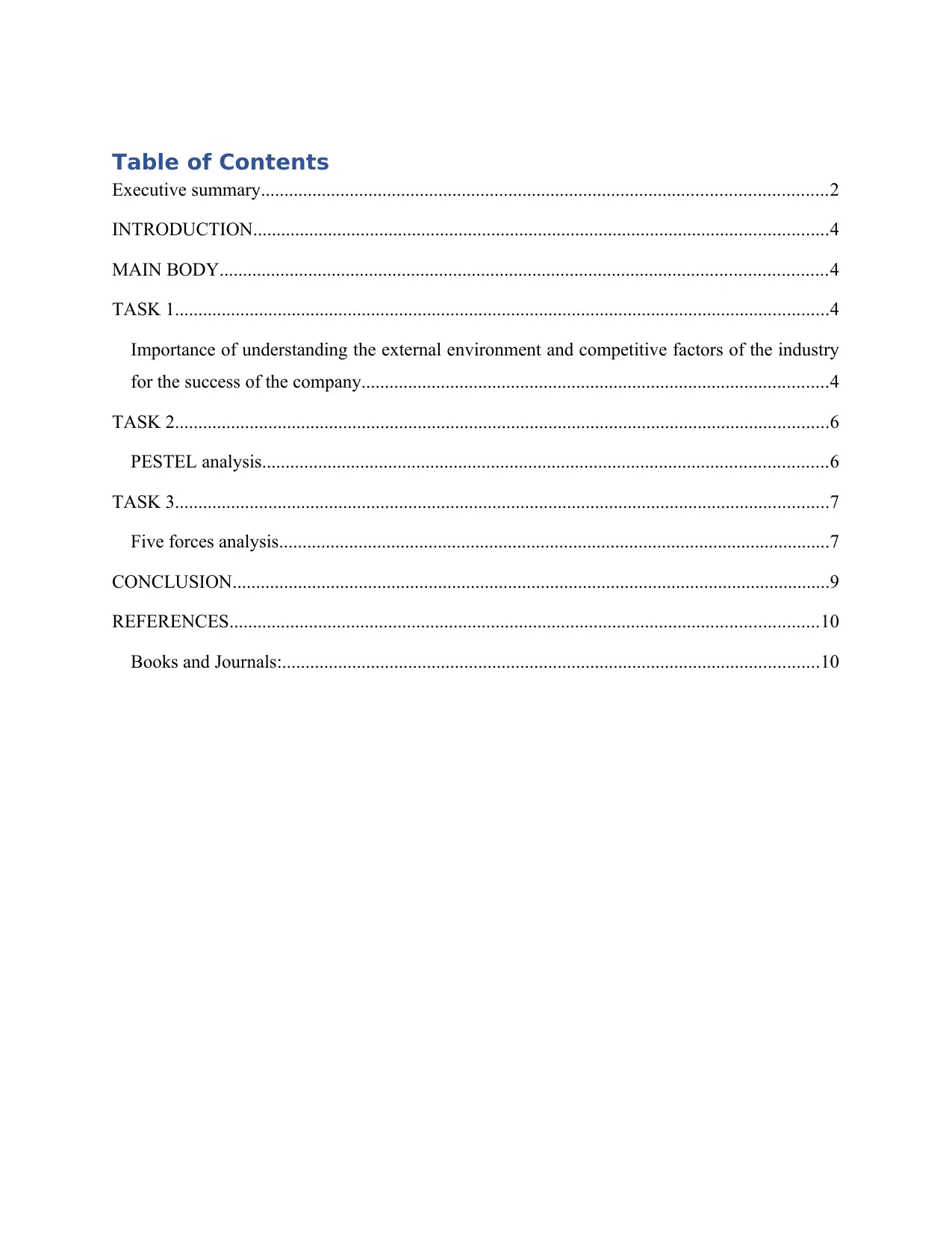
Table of Contents
Executive summary.........................................................................................................................2
INTRODUCTION...........................................................................................................................4
MAIN BODY..................................................................................................................................4
TASK 1............................................................................................................................................4
Importance of understanding the external environment and competitive factors of the industry
for the success of the company....................................................................................................4
TASK 2............................................................................................................................................6
PESTEL analysis.........................................................................................................................6
TASK 3............................................................................................................................................7
Five forces analysis......................................................................................................................7
CONCLUSION................................................................................................................................9
REFERENCES..............................................................................................................................10
Books and Journals:...................................................................................................................10
Executive summary.........................................................................................................................2
INTRODUCTION...........................................................................................................................4
MAIN BODY..................................................................................................................................4
TASK 1............................................................................................................................................4
Importance of understanding the external environment and competitive factors of the industry
for the success of the company....................................................................................................4
TASK 2............................................................................................................................................6
PESTEL analysis.........................................................................................................................6
TASK 3............................................................................................................................................7
Five forces analysis......................................................................................................................7
CONCLUSION................................................................................................................................9
REFERENCES..............................................................................................................................10
Books and Journals:...................................................................................................................10
⊘ This is a preview!⊘
Do you want full access?
Subscribe today to unlock all pages.

Trusted by 1+ million students worldwide
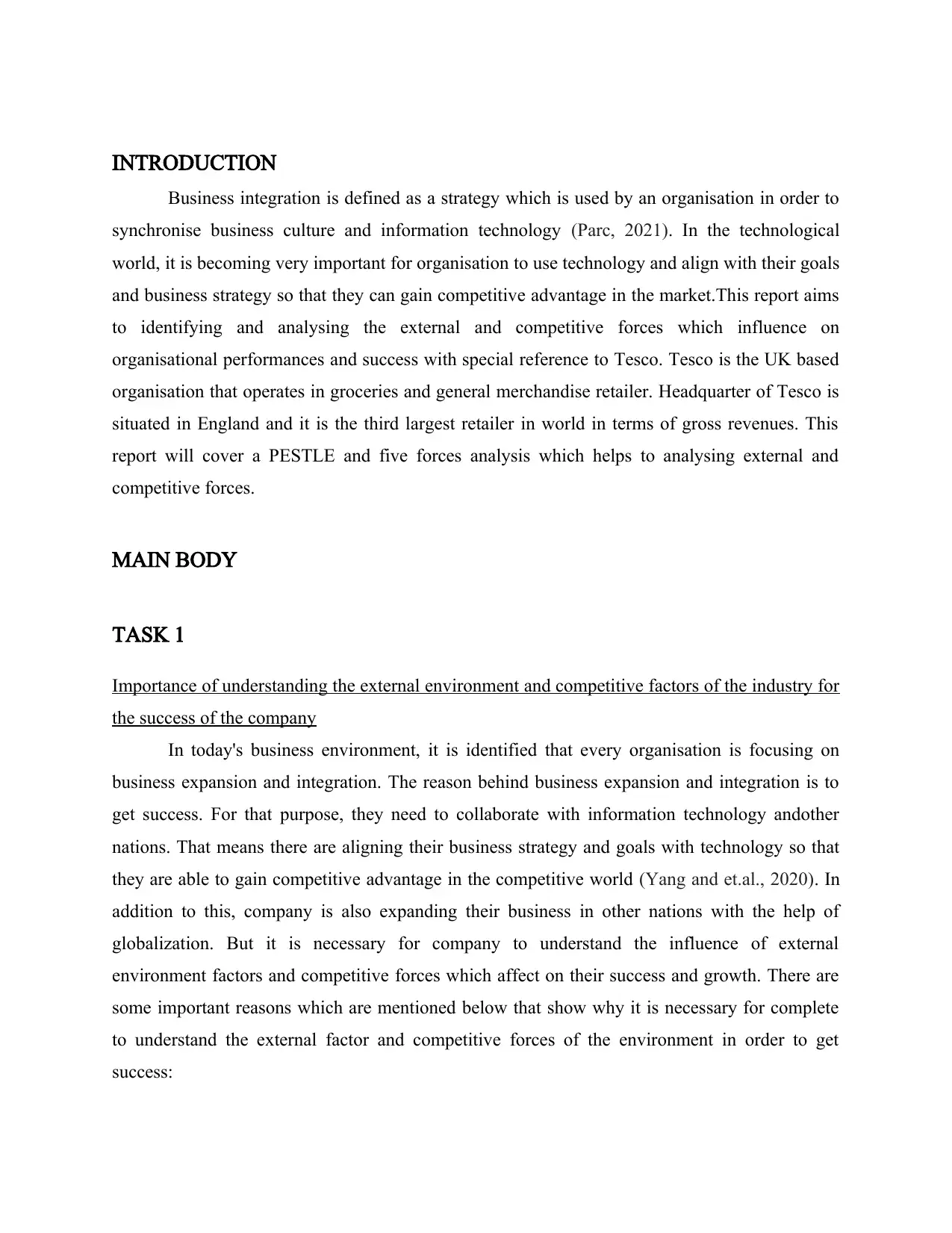
INTRODUCTION
Business integration is defined as a strategy which is used by an organisation in order to
synchronise business culture and information technology (Parc, 2021). In the technological
world, it is becoming very important for organisation to use technology and align with their goals
and business strategy so that they can gain competitive advantage in the market.This report aims
to identifying and analysing the external and competitive forces which influence on
organisational performances and success with special reference to Tesco. Tesco is the UK based
organisation that operates in groceries and general merchandise retailer. Headquarter of Tesco is
situated in England and it is the third largest retailer in world in terms of gross revenues. This
report will cover a PESTLE and five forces analysis which helps to analysing external and
competitive forces.
MAIN BODY
TASK 1
Importance of understanding the external environment and competitive factors of the industry for
the success of the company
In today's business environment, it is identified that every organisation is focusing on
business expansion and integration. The reason behind business expansion and integration is to
get success. For that purpose, they need to collaborate with information technology andother
nations. That means there are aligning their business strategy and goals with technology so that
they are able to gain competitive advantage in the competitive world (Yang and et.al., 2020). In
addition to this, company is also expanding their business in other nations with the help of
globalization. But it is necessary for company to understand the influence of external
environment factors and competitive forces which affect on their success and growth. There are
some important reasons which are mentioned below that show why it is necessary for complete
to understand the external factor and competitive forces of the environment in order to get
success:
Business integration is defined as a strategy which is used by an organisation in order to
synchronise business culture and information technology (Parc, 2021). In the technological
world, it is becoming very important for organisation to use technology and align with their goals
and business strategy so that they can gain competitive advantage in the market.This report aims
to identifying and analysing the external and competitive forces which influence on
organisational performances and success with special reference to Tesco. Tesco is the UK based
organisation that operates in groceries and general merchandise retailer. Headquarter of Tesco is
situated in England and it is the third largest retailer in world in terms of gross revenues. This
report will cover a PESTLE and five forces analysis which helps to analysing external and
competitive forces.
MAIN BODY
TASK 1
Importance of understanding the external environment and competitive factors of the industry for
the success of the company
In today's business environment, it is identified that every organisation is focusing on
business expansion and integration. The reason behind business expansion and integration is to
get success. For that purpose, they need to collaborate with information technology andother
nations. That means there are aligning their business strategy and goals with technology so that
they are able to gain competitive advantage in the competitive world (Yang and et.al., 2020). In
addition to this, company is also expanding their business in other nations with the help of
globalization. But it is necessary for company to understand the influence of external
environment factors and competitive forces which affect on their success and growth. There are
some important reasons which are mentioned below that show why it is necessary for complete
to understand the external factor and competitive forces of the environment in order to get
success:
Paraphrase This Document
Need a fresh take? Get an instant paraphrase of this document with our AI Paraphraser
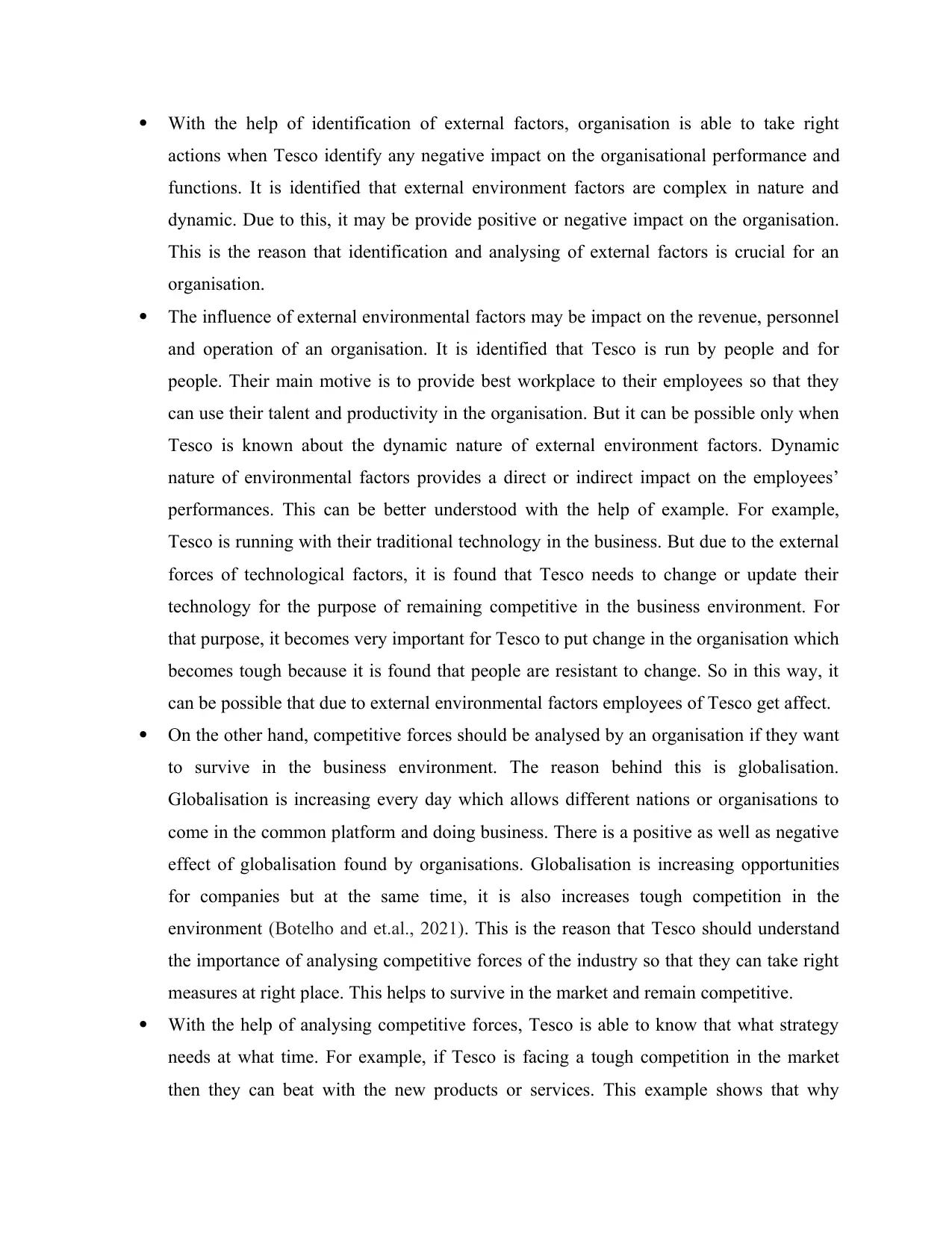
With the help of identification of external factors, organisation is able to take right
actions when Tesco identify any negative impact on the organisational performance and
functions. It is identified that external environment factors are complex in nature and
dynamic. Due to this, it may be provide positive or negative impact on the organisation.
This is the reason that identification and analysing of external factors is crucial for an
organisation.
The influence of external environmental factors may be impact on the revenue, personnel
and operation of an organisation. It is identified that Tesco is run by people and for
people. Their main motive is to provide best workplace to their employees so that they
can use their talent and productivity in the organisation. But it can be possible only when
Tesco is known about the dynamic nature of external environment factors. Dynamic
nature of environmental factors provides a direct or indirect impact on the employees’
performances. This can be better understood with the help of example. For example,
Tesco is running with their traditional technology in the business. But due to the external
forces of technological factors, it is found that Tesco needs to change or update their
technology for the purpose of remaining competitive in the business environment. For
that purpose, it becomes very important for Tesco to put change in the organisation which
becomes tough because it is found that people are resistant to change. So in this way, it
can be possible that due to external environmental factors employees of Tesco get affect.
On the other hand, competitive forces should be analysed by an organisation if they want
to survive in the business environment. The reason behind this is globalisation.
Globalisation is increasing every day which allows different nations or organisations to
come in the common platform and doing business. There is a positive as well as negative
effect of globalisation found by organisations. Globalisation is increasing opportunities
for companies but at the same time, it is also increases tough competition in the
environment (Botelho and et.al., 2021). This is the reason that Tesco should understand
the importance of analysing competitive forces of the industry so that they can take right
measures at right place. This helps to survive in the market and remain competitive.
With the help of analysing competitive forces, Tesco is able to know that what strategy
needs at what time. For example, if Tesco is facing a tough competition in the market
then they can beat with the new products or services. This example shows that why
actions when Tesco identify any negative impact on the organisational performance and
functions. It is identified that external environment factors are complex in nature and
dynamic. Due to this, it may be provide positive or negative impact on the organisation.
This is the reason that identification and analysing of external factors is crucial for an
organisation.
The influence of external environmental factors may be impact on the revenue, personnel
and operation of an organisation. It is identified that Tesco is run by people and for
people. Their main motive is to provide best workplace to their employees so that they
can use their talent and productivity in the organisation. But it can be possible only when
Tesco is known about the dynamic nature of external environment factors. Dynamic
nature of environmental factors provides a direct or indirect impact on the employees’
performances. This can be better understood with the help of example. For example,
Tesco is running with their traditional technology in the business. But due to the external
forces of technological factors, it is found that Tesco needs to change or update their
technology for the purpose of remaining competitive in the business environment. For
that purpose, it becomes very important for Tesco to put change in the organisation which
becomes tough because it is found that people are resistant to change. So in this way, it
can be possible that due to external environmental factors employees of Tesco get affect.
On the other hand, competitive forces should be analysed by an organisation if they want
to survive in the business environment. The reason behind this is globalisation.
Globalisation is increasing every day which allows different nations or organisations to
come in the common platform and doing business. There is a positive as well as negative
effect of globalisation found by organisations. Globalisation is increasing opportunities
for companies but at the same time, it is also increases tough competition in the
environment (Botelho and et.al., 2021). This is the reason that Tesco should understand
the importance of analysing competitive forces of the industry so that they can take right
measures at right place. This helps to survive in the market and remain competitive.
With the help of analysing competitive forces, Tesco is able to know that what strategy
needs at what time. For example, if Tesco is facing a tough competition in the market
then they can beat with the new products or services. This example shows that why
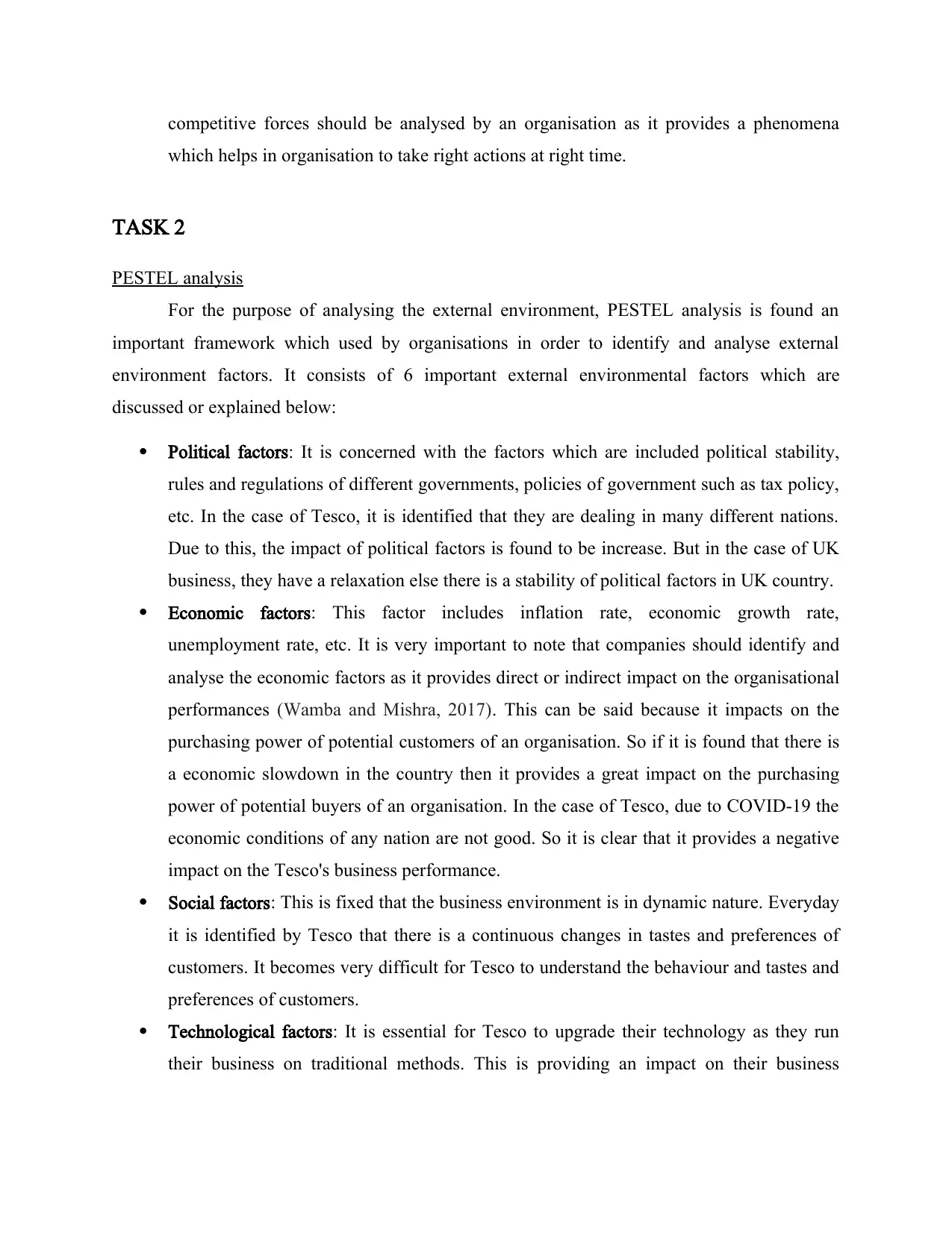
competitive forces should be analysed by an organisation as it provides a phenomena
which helps in organisation to take right actions at right time.
TASK 2
PESTEL analysis
For the purpose of analysing the external environment, PESTEL analysis is found an
important framework which used by organisations in order to identify and analyse external
environment factors. It consists of 6 important external environmental factors which are
discussed or explained below:
Political factors: It is concerned with the factors which are included political stability,
rules and regulations of different governments, policies of government such as tax policy,
etc. In the case of Tesco, it is identified that they are dealing in many different nations.
Due to this, the impact of political factors is found to be increase. But in the case of UK
business, they have a relaxation else there is a stability of political factors in UK country.
Economic factors: This factor includes inflation rate, economic growth rate,
unemployment rate, etc. It is very important to note that companies should identify and
analyse the economic factors as it provides direct or indirect impact on the organisational
performances (Wamba and Mishra, 2017). This can be said because it impacts on the
purchasing power of potential customers of an organisation. So if it is found that there is
a economic slowdown in the country then it provides a great impact on the purchasing
power of potential buyers of an organisation. In the case of Tesco, due to COVID-19 the
economic conditions of any nation are not good. So it is clear that it provides a negative
impact on the Tesco's business performance.
Social factors: This is fixed that the business environment is in dynamic nature. Everyday
it is identified by Tesco that there is a continuous changes in tastes and preferences of
customers. It becomes very difficult for Tesco to understand the behaviour and tastes and
preferences of customers.
Technological factors: It is essential for Tesco to upgrade their technology as they run
their business on traditional methods. This is providing an impact on their business
which helps in organisation to take right actions at right time.
TASK 2
PESTEL analysis
For the purpose of analysing the external environment, PESTEL analysis is found an
important framework which used by organisations in order to identify and analyse external
environment factors. It consists of 6 important external environmental factors which are
discussed or explained below:
Political factors: It is concerned with the factors which are included political stability,
rules and regulations of different governments, policies of government such as tax policy,
etc. In the case of Tesco, it is identified that they are dealing in many different nations.
Due to this, the impact of political factors is found to be increase. But in the case of UK
business, they have a relaxation else there is a stability of political factors in UK country.
Economic factors: This factor includes inflation rate, economic growth rate,
unemployment rate, etc. It is very important to note that companies should identify and
analyse the economic factors as it provides direct or indirect impact on the organisational
performances (Wamba and Mishra, 2017). This can be said because it impacts on the
purchasing power of potential customers of an organisation. So if it is found that there is
a economic slowdown in the country then it provides a great impact on the purchasing
power of potential buyers of an organisation. In the case of Tesco, due to COVID-19 the
economic conditions of any nation are not good. So it is clear that it provides a negative
impact on the Tesco's business performance.
Social factors: This is fixed that the business environment is in dynamic nature. Everyday
it is identified by Tesco that there is a continuous changes in tastes and preferences of
customers. It becomes very difficult for Tesco to understand the behaviour and tastes and
preferences of customers.
Technological factors: It is essential for Tesco to upgrade their technology as they run
their business on traditional methods. This is providing an impact on their business
⊘ This is a preview!⊘
Do you want full access?
Subscribe today to unlock all pages.

Trusted by 1+ million students worldwide
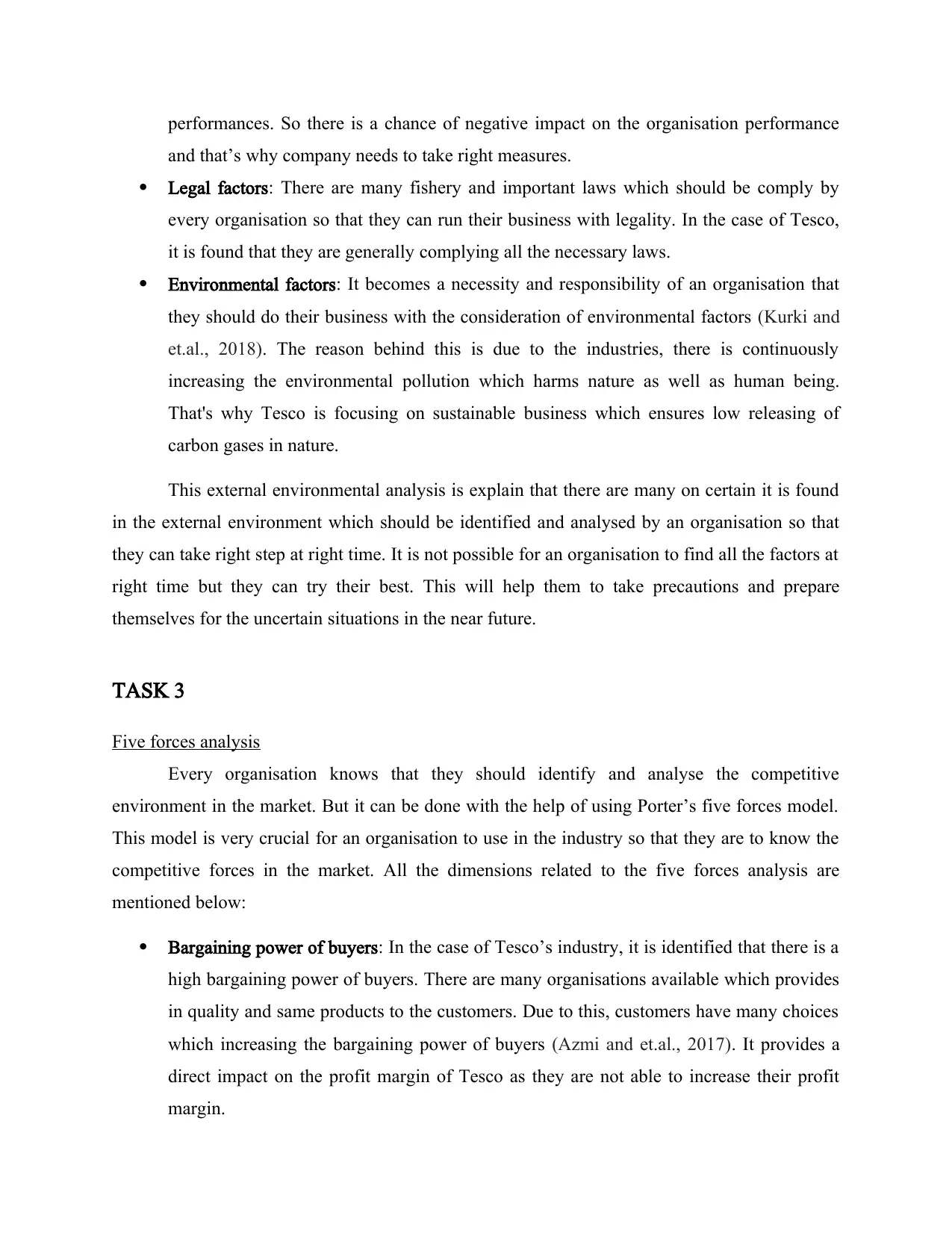
performances. So there is a chance of negative impact on the organisation performance
and that’s why company needs to take right measures.
Legal factors: There are many fishery and important laws which should be comply by
every organisation so that they can run their business with legality. In the case of Tesco,
it is found that they are generally complying all the necessary laws.
Environmental factors: It becomes a necessity and responsibility of an organisation that
they should do their business with the consideration of environmental factors (Kurki and
et.al., 2018). The reason behind this is due to the industries, there is continuously
increasing the environmental pollution which harms nature as well as human being.
That's why Tesco is focusing on sustainable business which ensures low releasing of
carbon gases in nature.
This external environmental analysis is explain that there are many on certain it is found
in the external environment which should be identified and analysed by an organisation so that
they can take right step at right time. It is not possible for an organisation to find all the factors at
right time but they can try their best. This will help them to take precautions and prepare
themselves for the uncertain situations in the near future.
TASK 3
Five forces analysis
Every organisation knows that they should identify and analyse the competitive
environment in the market. But it can be done with the help of using Porter’s five forces model.
This model is very crucial for an organisation to use in the industry so that they are to know the
competitive forces in the market. All the dimensions related to the five forces analysis are
mentioned below:
Bargaining power of buyers: In the case of Tesco’s industry, it is identified that there is a
high bargaining power of buyers. There are many organisations available which provides
in quality and same products to the customers. Due to this, customers have many choices
which increasing the bargaining power of buyers (Azmi and et.al., 2017). It provides a
direct impact on the profit margin of Tesco as they are not able to increase their profit
margin.
and that’s why company needs to take right measures.
Legal factors: There are many fishery and important laws which should be comply by
every organisation so that they can run their business with legality. In the case of Tesco,
it is found that they are generally complying all the necessary laws.
Environmental factors: It becomes a necessity and responsibility of an organisation that
they should do their business with the consideration of environmental factors (Kurki and
et.al., 2018). The reason behind this is due to the industries, there is continuously
increasing the environmental pollution which harms nature as well as human being.
That's why Tesco is focusing on sustainable business which ensures low releasing of
carbon gases in nature.
This external environmental analysis is explain that there are many on certain it is found
in the external environment which should be identified and analysed by an organisation so that
they can take right step at right time. It is not possible for an organisation to find all the factors at
right time but they can try their best. This will help them to take precautions and prepare
themselves for the uncertain situations in the near future.
TASK 3
Five forces analysis
Every organisation knows that they should identify and analyse the competitive
environment in the market. But it can be done with the help of using Porter’s five forces model.
This model is very crucial for an organisation to use in the industry so that they are to know the
competitive forces in the market. All the dimensions related to the five forces analysis are
mentioned below:
Bargaining power of buyers: In the case of Tesco’s industry, it is identified that there is a
high bargaining power of buyers. There are many organisations available which provides
in quality and same products to the customers. Due to this, customers have many choices
which increasing the bargaining power of buyers (Azmi and et.al., 2017). It provides a
direct impact on the profit margin of Tesco as they are not able to increase their profit
margin.
Paraphrase This Document
Need a fresh take? Get an instant paraphrase of this document with our AI Paraphraser
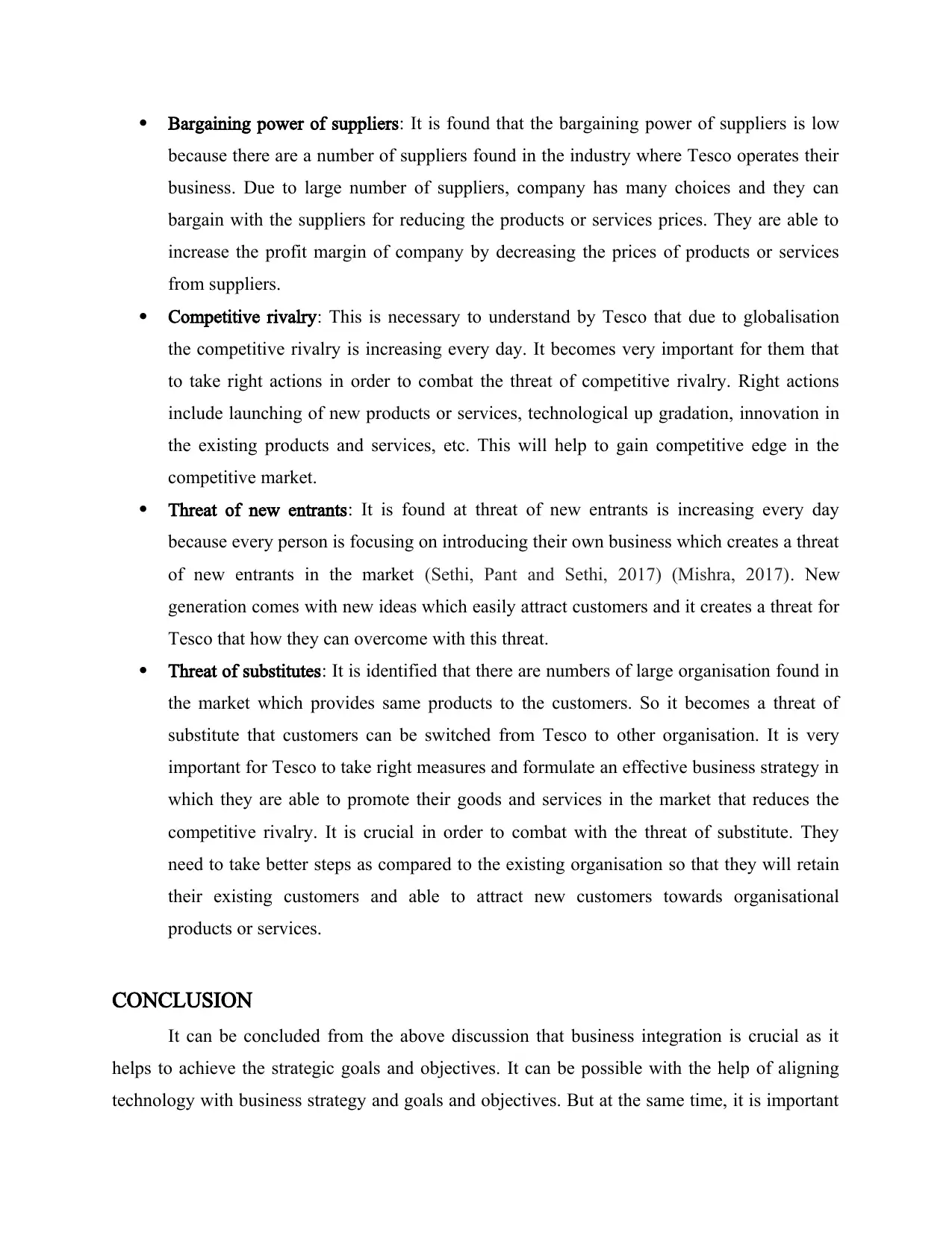
Bargaining power of suppliers: It is found that the bargaining power of suppliers is low
because there are a number of suppliers found in the industry where Tesco operates their
business. Due to large number of suppliers, company has many choices and they can
bargain with the suppliers for reducing the products or services prices. They are able to
increase the profit margin of company by decreasing the prices of products or services
from suppliers.
Competitive rivalry: This is necessary to understand by Tesco that due to globalisation
the competitive rivalry is increasing every day. It becomes very important for them that
to take right actions in order to combat the threat of competitive rivalry. Right actions
include launching of new products or services, technological up gradation, innovation in
the existing products and services, etc. This will help to gain competitive edge in the
competitive market.
Threat of new entrants: It is found at threat of new entrants is increasing every day
because every person is focusing on introducing their own business which creates a threat
of new entrants in the market (Sethi, Pant and Sethi, 2017) (Mishra, 2017). New
generation comes with new ideas which easily attract customers and it creates a threat for
Tesco that how they can overcome with this threat.
Threat of substitutes: It is identified that there are numbers of large organisation found in
the market which provides same products to the customers. So it becomes a threat of
substitute that customers can be switched from Tesco to other organisation. It is very
important for Tesco to take right measures and formulate an effective business strategy in
which they are able to promote their goods and services in the market that reduces the
competitive rivalry. It is crucial in order to combat with the threat of substitute. They
need to take better steps as compared to the existing organisation so that they will retain
their existing customers and able to attract new customers towards organisational
products or services.
CONCLUSION
It can be concluded from the above discussion that business integration is crucial as it
helps to achieve the strategic goals and objectives. It can be possible with the help of aligning
technology with business strategy and goals and objectives. But at the same time, it is important
because there are a number of suppliers found in the industry where Tesco operates their
business. Due to large number of suppliers, company has many choices and they can
bargain with the suppliers for reducing the products or services prices. They are able to
increase the profit margin of company by decreasing the prices of products or services
from suppliers.
Competitive rivalry: This is necessary to understand by Tesco that due to globalisation
the competitive rivalry is increasing every day. It becomes very important for them that
to take right actions in order to combat the threat of competitive rivalry. Right actions
include launching of new products or services, technological up gradation, innovation in
the existing products and services, etc. This will help to gain competitive edge in the
competitive market.
Threat of new entrants: It is found at threat of new entrants is increasing every day
because every person is focusing on introducing their own business which creates a threat
of new entrants in the market (Sethi, Pant and Sethi, 2017) (Mishra, 2017). New
generation comes with new ideas which easily attract customers and it creates a threat for
Tesco that how they can overcome with this threat.
Threat of substitutes: It is identified that there are numbers of large organisation found in
the market which provides same products to the customers. So it becomes a threat of
substitute that customers can be switched from Tesco to other organisation. It is very
important for Tesco to take right measures and formulate an effective business strategy in
which they are able to promote their goods and services in the market that reduces the
competitive rivalry. It is crucial in order to combat with the threat of substitute. They
need to take better steps as compared to the existing organisation so that they will retain
their existing customers and able to attract new customers towards organisational
products or services.
CONCLUSION
It can be concluded from the above discussion that business integration is crucial as it
helps to achieve the strategic goals and objectives. It can be possible with the help of aligning
technology with business strategy and goals and objectives. But at the same time, it is important
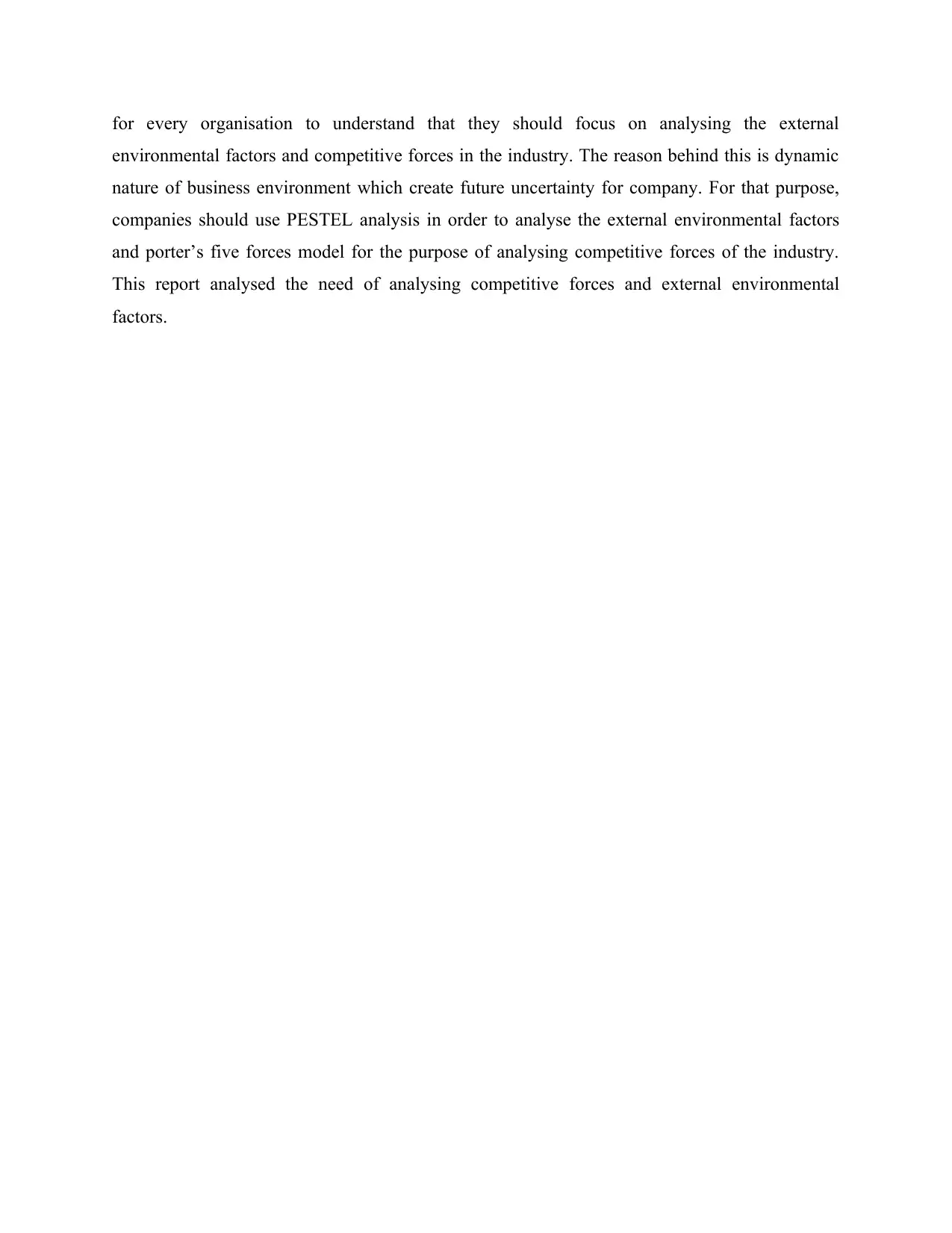
for every organisation to understand that they should focus on analysing the external
environmental factors and competitive forces in the industry. The reason behind this is dynamic
nature of business environment which create future uncertainty for company. For that purpose,
companies should use PESTEL analysis in order to analyse the external environmental factors
and porter’s five forces model for the purpose of analysing competitive forces of the industry.
This report analysed the need of analysing competitive forces and external environmental
factors.
environmental factors and competitive forces in the industry. The reason behind this is dynamic
nature of business environment which create future uncertainty for company. For that purpose,
companies should use PESTEL analysis in order to analyse the external environmental factors
and porter’s five forces model for the purpose of analysing competitive forces of the industry.
This report analysed the need of analysing competitive forces and external environmental
factors.
⊘ This is a preview!⊘
Do you want full access?
Subscribe today to unlock all pages.

Trusted by 1+ million students worldwide

REFERENCES
Books and Journals:
Azmi, I., and et.al., 2017. Logistics and supply chain management: The importance of integration
for business processes.
Journal of emerging economies and Islamic Research,
5(4), pp.73-
80.
Botelho, D.F., and et.al., 2021. Innovative business models as drivers for prosumers integration-
Enablers and barriers.
Renewable and Sustainable Energy Reviews,
144, p.111057.
Kurki, T., and et.al., 2018. Integration becoming business: Marketisation of integration training
for immigrants.
European Educational Research Journal,
17(2), pp.233-247.
Mishra, S., 2017. Integration of talent and mobility function: strategy for HR to manage
business.
Strategic Hr Review.
Parc, J., 2021. Business integration and its impact on film industry: The case of Korean film
policies from the 1960s until the present.
Business History,
63(5), pp.850-867.
Sethi, R., Pant, S. and Sethi, A., 2017. Integrating business-to-business customers in original
equipment manufacturers’ supply chains through information systems
integration.
European Journal of Management Studies,
22(2), pp.125-162.
Wamba, S.F. and Mishra, D., 2017. Big data integration with business processes: a literature
review.
Business Process Management Journal.
Yang, R., and et.al., 2020. Public and private blockchain in construction business process and
information integration.
Automation in construction,
118, p.103276.
Books and Journals:
Azmi, I., and et.al., 2017. Logistics and supply chain management: The importance of integration
for business processes.
Journal of emerging economies and Islamic Research,
5(4), pp.73-
80.
Botelho, D.F., and et.al., 2021. Innovative business models as drivers for prosumers integration-
Enablers and barriers.
Renewable and Sustainable Energy Reviews,
144, p.111057.
Kurki, T., and et.al., 2018. Integration becoming business: Marketisation of integration training
for immigrants.
European Educational Research Journal,
17(2), pp.233-247.
Mishra, S., 2017. Integration of talent and mobility function: strategy for HR to manage
business.
Strategic Hr Review.
Parc, J., 2021. Business integration and its impact on film industry: The case of Korean film
policies from the 1960s until the present.
Business History,
63(5), pp.850-867.
Sethi, R., Pant, S. and Sethi, A., 2017. Integrating business-to-business customers in original
equipment manufacturers’ supply chains through information systems
integration.
European Journal of Management Studies,
22(2), pp.125-162.
Wamba, S.F. and Mishra, D., 2017. Big data integration with business processes: a literature
review.
Business Process Management Journal.
Yang, R., and et.al., 2020. Public and private blockchain in construction business process and
information integration.
Automation in construction,
118, p.103276.
1 out of 10
Related Documents
Your All-in-One AI-Powered Toolkit for Academic Success.
+13062052269
info@desklib.com
Available 24*7 on WhatsApp / Email
![[object Object]](/_next/static/media/star-bottom.7253800d.svg)
Unlock your academic potential
Copyright © 2020–2025 A2Z Services. All Rights Reserved. Developed and managed by ZUCOL.





